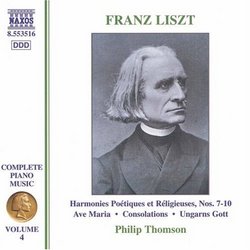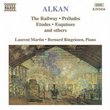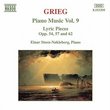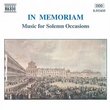| All Artists: Franz Liszt, Philip Thomson Title: Liszt: Complete Piano Music, Vol. 4 Members Wishing: 0 Total Copies: 0 Label: Naxos Release Date: 8/5/1997 Genre: Classical Styles: Forms & Genres, Short Forms, Suites, Instruments, Keyboard Number of Discs: 1 SwapaCD Credits: 1 UPC: 730099451628 |
Search - Franz Liszt, Philip Thomson :: Liszt: Complete Piano Music, Vol. 4
 | Franz Liszt, Philip Thomson Liszt: Complete Piano Music, Vol. 4 Genre: Classical
|
Larger Image |
CD DetailsSimilar CDs |
CD ReviewsLiszt - Rage, Religion, Romanticism Hexameron | 06/30/2006 (5 out of 5 stars) "In Naxos' Volume 4 of the Complete Piano Music of Liszt, Philip Thomson completes his recordings of the 'Harmonies Poetiques et Religieuses.' Thomson's stellar pianism and musicianship continues to impress me. His efforts in Volume 3 produced the most glorious "Pensee des Morts" I've ever heard. I was anxious to hear Thomson excavate the depths of the rest of the profound 'Harmonies Poetiques et Religieuses' and I'm pleased to say he is victorious. In addition to completing the 'Harmonies' cycle, he also exhibits other rarer pieces from Liszt's neglected oeuvre, including numerous Ave Maria's and the wonderful Six Consolations. The left hand version of Ungarns Gott is not as effective as the two hand version and is probably better appreciated by watching a pianist perform it.
As the owner of the complete 59 volume Liszt series on the Hyperion label, I've pretty much heard every Liszt composition that has been recorded. I'm not a Liszt scholar, but I have to say that there are many, including myself, who believe the 'Harmonies Poetiques et Religieuses' Liszt's greatest and most underrated series of piano works. Liszt actually started sketches of his 'Harmonies' as far back as 1840. He essentially created two cycles dating from 1847 and 1853, and most listeners are familiar with the latter and final version. The first piece, "Funerailles" is universally recognized by pianists and Lisztians as a powerful work of angst, rage, and funereal expression. Philip Thomson calls it, "Dark, poignant, defiant, and tragic, just as the events were that inspired it. More powerful or heartfelt funeral music than this has not been penned." I whole-heartedly agree. Thomson's crystalline interpretation is most refreshing, too. After hearing so many dense and bombastic renditions out there (Argerich), Thomson's is controlled and yet still brooding and explosive. "Miserere d'apres Palestrina" recalls a Renaissance sound world on the piano and conveys Liszt's dramatic and effective use of arpeggios, which are not devices for showmanship but thematic ideas unto themselves. The most successful execution Thomson makes is in the "Andante lagrimoso." I have not heard a more lyrical, mournful and utterly depressing version of this work, one that musically oozes tears. Again, I quote Philip Thomson on the music: "The only untitled piece of this set is known by its tempo marking, and is lagrimoso indeed: its initial sighs try their best to transform themselves into at least a semblance of resigned acceptance, but ultimately they cannot. The work ends with the understanding that some tragedies cannot be mitigated by any amount of hope." The last piece of the set, "Cantique d'amour," is typical of Liszt's Romantic sensibilities: over-the-top passion, lyrical melody, and a dramatic presentation. One last time, I use Philip Thomson's astute observations to vouche for the music: "The last piece of the set is immediately graspable and irresistible in all respects. Simple in form, and overtly and unashamedly romantic, it is the antithesis of the mood set by the 'Andante lagrimoso.' These last two pieces taken together represent the need for, and the ability of, music to show us what life is: utter hopelessness at war with the hope we must have if we are to live. Our human life may be painful and tragic, and our aspirations ludicrous and doomed, but it is not only possible but necessary that we live and hope earnestly and nobly. The 'Cantique d'amour' is the expression of the indomitable human spirit that has always defied the odds." I hope it's clear by now that Thomson is not a commercial pianist merely playing the notes in front of him; he really thinks about the emotional nuances and point of each piece. The four various "Ave Maria" works, all different and composed at different times in Liszt's life, are mellow, gentle and reflective. They each have their own individual figurations and thematic ideas that suggest Brahms or Grieg. The Six Consolations, on the other hand, are the epitomy of Liszt's gorgeous poetical ideas inspired by Chopin's example. The Third Consolation is most famous and sits beside his Liebestraume's as romantic and tender pieces of love. Thomson's elegant and patient performance of these gems is astounding; I find them infinitely better than Howard's examples. Bottom line: Philip Thomson understands Liszt's idiom and he is an incredibly proficient Liszt interpreter. I no longer listen to any other recordings of the 'Harmonies Poetiques et Religieuses' but Thomson's." |

 Track Listings (15) - Disc #1
Track Listings (15) - Disc #1



